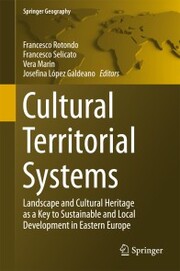-
Zusatztext
-
<p></p><p>This book seeks to enhance the cultural dimension of sustainable development and particularly focuses on minor historic centers and their natural and rural landscapes. In a society becoming ever more globalized, without territorial restrictions in the production of goods and able to reproduce in China the goods and product characteristic of South American crafts (to mention just two extremes), the only element that can still be contextualized is heritage identity: the result of close integration between cultural assets, intangible assets and settled communities.</p><p> Thus, heritage identity is one of the few elements, together with natural resources, which has the potential for economic development that is still firmly rooted in places and local populations. These towns are often the centerpiece of urban landscapes and geographical areas with original features, not always but often as individual places within networks of minor historical centers linked by shared history, traditions and/or natural elements (rivers, forests, river systems or other natural elements). They are outside the major tourist networks, even if now there is a budding interest in the touristic exploitation of these environments. So, they are the right places to pursue a sustainable and local development with a cultural perspective.</p><p> This book is a product of the VIVA_EASTPART project (Valorisation and Improving of management of Small Historic Centres in the eastern PARTnership region), under the EU-funded ENPI Eastern Partnership program. It complements the more practically-focused work that is in production from this group, more focused on empirical approaches to the development of minor historic centers of the nations involved. Though the book has been influenced by this research and working experience, the authors are solely responsible for the content and opinions presented.</p>
-
-
Kurztext
-
This book seeks to enhance the cultural dimension of sustainable development and particularly focuses on minor historic centers and their natural and rural landscapes. In a society becoming ever more globalized, without territorial restrictions in the production of goods and able to reproduce in China the goods and product characteristic of South American crafts (to mention just two extremes), the only element that can still be contextualized is heritage identity: the result of close integration between cultural assets, intangible assets and settled communities. Thus, heritage identity is one of the few elements, together with natural resources, which has the potential for economic development that is still firmly rooted in places and local populations. These towns are often the centerpiece of urban landscapes and geographical areas with original features, not always but often as individual places within networks of minor historical centers linked by shared history, traditions and/or natural elements (rivers, forests, river systems or other natural elements). They are outside the major tourist networks, even if now there is a budding interest in the touristic exploitation of these environments. So, they are the right places to pursue a sustainable and local development with a cultural perspective. This book is a product of the VIVA_EASTPART project (Valorisation and Improving of management of Small Historic Centres in the eastern PARTnership region), under the EU-funded "e;ENPI Eastern Partnership"e; program. It complements the more practically-focused work that is in production from this group, more focused on empirical approaches to the development of minor historic centers of the nations involved. Though the book has been influenced by this research and working experience, the authors are solely responsible for the content and opinions presented.
-
Detailansicht
Cultural Territorial Systems
eBook - Landscape and Cultural Heritage as a Key to Sustainable and Local Development in Eastern Europe, Springer Geography
ISBN/EAN: 9783319207537
Umbreit-Nr.: 9281884
Sprache:
Englisch
Umfang: 0 S., 18.36 MB
Format in cm:
Einband:
Keine Angabe
Erschienen am 19.04.2016
Auflage: 1/2016
E-Book
Format: PDF
DRM: Digitales Wasserzeichen


